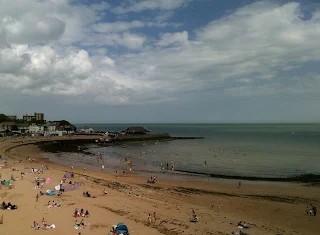This is one cuter than cute little seaside village!
It's smaller and more quaint than Margate but comes across as a bit more cultured and, luckily, more "occupied"- the town is tinier but what it does have appears to be thriving, whilst there are lots of boarded up shops in Margate. Mind you, bear in mind that I visited in peak season- what it's like in winter is possibly a different matter.
Here is the attractive and busy bay.
This is the...I'll call it a "harbour" arm, but it's very small and hardly even that...
Here's the saltwater tidal swimming pool.
This is the view from the beach. I'm not surprised that J.M.W. Turner liked to come here to paint- the skies were very moody and interesting.
We popped into the Dickens House Museum, which is a must-see for all fans- it's housed in the cottage that was his inspiration for the home of Betsey Trotwood, in David Copperfield (which I have read, albeit many moons ago).
I have also read Great Expectations (I love, love, LOVE the character of Miss Havisham), A Christmas Carol (who hasn't?) and Bleak House. I have seen Oliver Twist performed live and on TV, but have never read it (I will do, though) and am currently reading The Old Curiosity Shop. I will make a point of reading all of Dickens' work.
The house also contains other Victorian memorabilia and has a lovely old boy in charge.
This is the magnificent Bleak House, further up on the headland. It was once called Fort House, Dickens lived here whilst planning the book and its appearance and position did inspire the title.
Here is the garden view, taken from the terrace.
This is the study where Dickens worked. I'm not sure if you're supposed to, but I sat in the chair and made a wish that some of Dickens' luck with his writing career would rub off on me!
Down in the cellars there is a smuggling museum, and the site is the end of one of the smugglers' old tunnels. This is extremely interesting- don't leave Broadstairs without taking a look at it- and was possibly the best part of the day.
Sadly, my camera decided to die (well, enough to not be able to function with a flash), so this is a PDF of a display in the Smugglers Museum.
Another PDF, and this skeletal chap had been a victim of "Redcapping." He was a revenue informer (a business just as lucrative as smuggling), and one way of dealing with those who broke the smuggler's unwritten law was to stake him out at low tide with a red lantern by his head. The spy would not be released until the lantern had gone out. Nice!
We did wonder if this is why the Royal Military Police wear red caps but no, it's believed that the colour was chosen by the wife of the Provost Major, in 1885- although another theory mentions that an Indian Military Police unit wore red turbans during the Indian Mutiny.
Other sayings are also believed to have come from smuggling. Instead of a constant light, which might have alerted the excise men, the smugglers used a flash to let incoming boats know that the "coast is clear." "Flash in the pan" comes from smugglers signalling by removing the top chamber of a gun by modifying it so that gunpowder could be placed in it and lit, giving off a brief, bright flare.
Other sayings are also believed to have come from smuggling. Instead of a constant light, which might have alerted the excise men, the smugglers used a flash to let incoming boats know that the "coast is clear." "Flash in the pan" comes from smugglers signalling by removing the top chamber of a gun by modifying it so that gunpowder could be placed in it and lit, giving off a brief, bright flare.
We finished our day with a look at Crampton Tower Museum, which is dedicated to Thomas Russell Crampton, chiefly remembered as a designer of locomotives and railways, but also involved with gas and waterworks.
It's a little town with several pretty charity/ vintage shops and individual boutiques, and also a fair few places to eat. It's a must for Charles Dickens fans but small and easy to traverse in half a day.











No comments:
Post a Comment